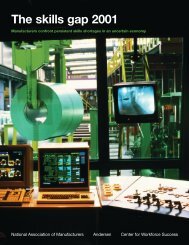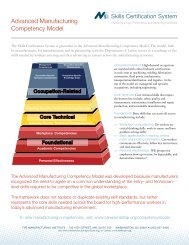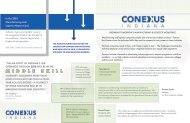2005 Skills Gap Report - Manufacturing Institute
2005 Skills Gap Report - Manufacturing Institute
2005 Skills Gap Report - Manufacturing Institute
You also want an ePaper? Increase the reach of your titles
YUMPU automatically turns print PDFs into web optimized ePapers that Google loves.
<strong>2005</strong> <strong>Skills</strong> <strong>Gap</strong> <strong>Report</strong><br />
A Public-Private<br />
Collaboration<br />
Clearly, the ability of manufacturers to attract, retain, and develop a<br />
high-performance workforce is of major importance to our nation as a<br />
whole. This challenge presents a significant opportunity for collaboration<br />
between the public and private sectors. Manufacturers are not<br />
expecting government to solve the problem for them, but would like<br />
encouragement and support for investments in training programs.<br />
Our survey indicates that a very large percentage of respondents<br />
either has never heard of the government workforce programs or has<br />
never been contacted by Workforce Investment boards. Undoubtedly,<br />
increased communication and collaboration are required to better utilize<br />
these programs and to improve the effectiveness of the public education<br />
system in preparing students for the workplace and future careers.<br />
Recommendations for Individual<br />
and Shared Responsibility<br />
The issues associated with the skills gap are numerous and complex.<br />
Yet with increased competition from countries around the world, the<br />
future success and vibrancy of the American manufacturing industry is<br />
now at stake. To hold back further competitive encroachments, all the<br />
parties must assume responsibility – including manufacturing companies,<br />
the government, educators, and individuals. We believe the<br />
urgency of this situation also requires the follow actions:<br />
• Educators must emphasize science, math and technology-related<br />
programs in K-16 curricula, invest more in effective teacher education<br />
focused on science and math, and ensure that programs<br />
regarding career opportunities and requirements for graduation are<br />
geared for 21st century employment.<br />
• Employers should invest at least three percent of payroll whenever<br />
possible to provide training opportunities for their current employees,<br />
particularly in areas that will enable them to become a high-performance<br />
workforce, learn new methods to attract, retain, develop and<br />
motivate employees,<br />
• State and federal government should invest in the capacity of<br />
community and technical colleges to prepare individuals for<br />
careers in high growth industries such as manufacturing<br />
• State education standards should include career education as<br />
measurable criteria for K-12 success<br />
• The Higher Education Act and its funding mechanisms should<br />
provide increased access for adult learners<br />
• Individuals must take responsibility for their own careers and employability<br />
by earning industry relevant certifications and formal education<br />
credentials such as community college and bachelor degrees.<br />
• The public workforce system, companies and their business associations<br />
must strengthen their engagement in order to better advise Workforce<br />
Investment Boards on rising and declining economic conditions, business<br />
investments, skill needs and employment requirements.<br />
• Public/private partnerships should be encouraged to support career<br />
awareness campaigns that help individuals understand all the career<br />
options available to them. A model for this is The <strong>Manufacturing</strong><br />
<strong>Institute</strong>’s Dream It Do It manufacturing careers campaign.<br />
3







